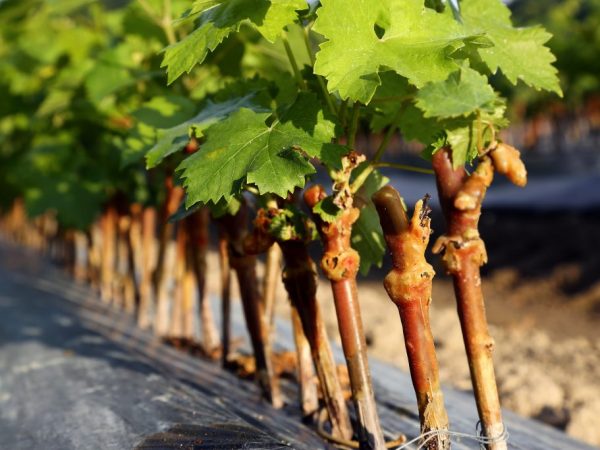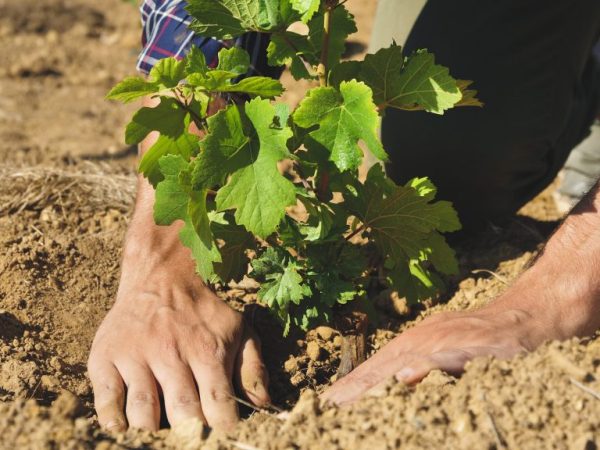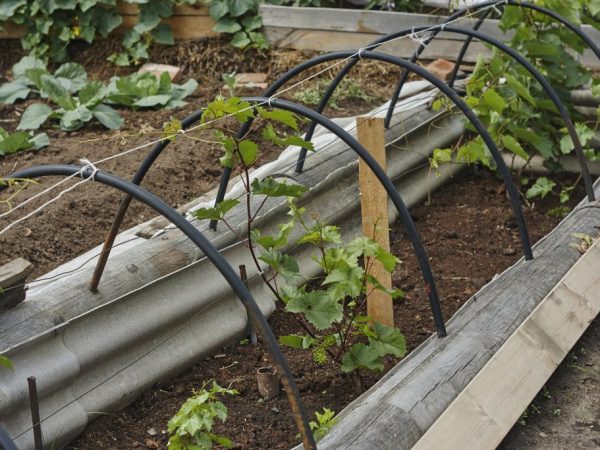Rules for planting grapes by cuttings in autumn
To get a good harvest of grapes, you need to know how to care for the vine, how grapes are planted with cuttings in the fall and what diseases lie in wait for.

Rules for planting grapes by cuttings in autumn
Features of cuttings
To grow grapes, they must be multiplied. Reproduction occurs by seeds and vegetatively. The seed method is used by breeders. Under normal conditions, a vegetative method is used, which is divided into the following subspecies:
- removal of the vine;
- graft;
- planting cuttings.
When cuttings, the entire biological complex from the main bush is preserved in the vine.
This is due to the ability of grapes to regenerate, i.e. complete healing of wounds on the roots, leaf stalks, stems and other parts of the vine. It is easier to plant varietal grapes with cuttings in the fall.
Seedling preparation
Before planting grapes by cuttings in the fall, the vine is cut and prepared. The process of harvesting cuttings:
- healthy;
- with a ripe vine;
- the length of the vine is 1.2 m, the thickness is 8-10 mm;
- white root cut;
- 3-4 buds on the selected vine.
The vine should crackle slightly when bent. On the cut, the main healthy root is white, and the young root is green. When pressed, the eyes do not crumble in a healthy vine.
To plant grapes in autumn with cuttings, they should not be dried or wrapped in plastic. Insufficient moisture destroys the cut vine, and poor ventilation will give an impetus to the decay of the trunk. For planting, grape cuttings are selected in the fall, with a bud on a segment of shoots.
Rooting
The rooting procedure is being carried out. Separate the selected vine from the root, cut into pieces (cuttings), 35-45 cm long, taking into account 3 buds on each. Cuts are made near the eye with a sharp knife or razor.
The cuttings are soaked in clean water at room temperature for 48 hours. After that, the upper cut is dipped in paraffin and the lower end is dipped into a special solution with stimulants (left for a day).
After the procedures, the grapes take root better. Storage and cultivation of this material in spring is possible.
Kilchevanie
After kilchevaniya, roots and callus appear on the sprout. The cut vines should first sit in a naturally heated container. For this, a substrate is prepared, in which there are steamed sawdust from hardwoods, pretreated with potassium permanganate. Wet sphagnum moss, hydrogel and coarse wet sand are added to the sawdust.
The substrate saturates the process with moisture, supports it, and the formation of callus is faster. The substrate needs to be watered, then roots will quickly form on the cuttings. This method of propagating and rooting cuttings is simple and effective.
Soil selection

It is not recommended to plant grapes in swampy soil.
A soil with a large amount of humus and a depth of groundwater up to 2.5-3 m is chosen. Stony and dark soils are also suitable, they perfectly absorb excess radiation from the sun.
Plants do not take root well in wetlands.The lack of oxygen in the soil will ruin it.
Ripens quickly on light-colored sandy soil. Shoots grow quickly on black soil or red soil.
At home, it is better to plant the vine in light soil (super sandy soil, chestnut soil or gray soil). It warms up quickly. If the soil is heavy at the landing site, sand or other available drainage material is added to it. To improve the quality of the soil, rotted manure is added. Soils with abundant amounts of salt are watered and drained before planting.
In places of old vineyards, plant new plants 3-4 years after uprooting. The ventilated southern slopes of the hills, closed from winter drafts, are well suited. Plant effectively in the soil prepared by the plantation. This method consists in the complete transshipment of the soil and its fertilization.
Planting cuttings
The growth and development of the plant depends on the autumn planting. There are two ways: vertical and tilted.
For tilted planting, the roots are cut to 10 cm under the second knot. Plant the seedlings in the south-north direction (for vertical two-lane trellises). Prepare trenches up to 1 m wide and 50 cm deep.
So that there is a lot of space for the roots, fertilizers with minerals and humus are used. Crushed stone or fine gravel is suitable for drainage. It is mixed with fertile soil mixture and poured into the trench. After that, the seedling is placed in a ditch and sequentially sprinkled with humus and earth with rubble. The top soil layer (1 centimeter) remains without drainage. To plant, keeping the distance between seedlings up to 2.5 m, and between rows up to 3 m.
For good photosynthesis, it is important for all grape leaves to get sunlight. Therefore, when using trellises with a visor, the disembarkation is done in an east-west direction.
Single cuttings are planted side by side on a common support or each separately, on an individual support. The distance depends on the characteristics of the variety (from 1 to 3 m).
The root system of the vineyard develops quickly, this is taken into account when planting in a permanent place and the necessary distance between the cuttings is clearly maintained so that later not to transplant and not injure the plant.
Preparing for the winter period

Protect plants from frost
Rooting and cultivation begins from the first days of October until frost. To prevent freezing of young roots, the following event is carried out:
- cut plastic bottles are prepared;
- cover the cuttings with them;
- plentiful watering is done beforehand (4 buckets of water for each);
- the soil around is loosened and mulched.
Before the onset of persistent frosts, the young seedling is covered with covering materials (sawdust, cut grass, needles, etc.). Or a hill is made around the plant, from the adjacent soil, to a height of 35-40 cm. Such a shelter allows the bush to develop and breathe. The next season will make a good grape bush.
Landing in the northern regions
The lower part of the cutting goes deep into the soil up to 50 cm - this prevents the root system from freezing, and rooting is better. For planting in such conditions, the rhizome on the seedling is selected up to 3 cm.
Care after landing
After planting the cuttings in the ground, the hole is compacted and thoroughly watered. Unwaxed plants in dry weather require constant attention, hilling and watering. This is done before the first shoots appear.
Mulching and 2-time loosening with simultaneous watering are carried out. The layers of earth do not need to be turned over. It is important not to move organic fertilizers around the bottom of the vine (for the first 3 years after planting).
To form a bush, 2 buds are left on the cuttings, after the shoot grows up to 8 cm. The rest of the shoots break off. All superficial roots are removed. This is called katarovka.
Disease prevention
For grapes, gray or white rot, anthracciosis, odium and other viral, fungal diseases are dangerous.
Despite the fact that planted cuttings in the fall cope better with the infection than spring cuttings, preventive measures are taken: spraying with a liquid of copper sulfate, fungicide and Bordeaux mixture.
In order to avoid transmission of infection from other trees, grapes are planted separately, away from the garden plantings. The near-trunk zone is carefully cleaned, weeds and the accumulation of fallen leaves or fruits are not allowed in it.
Conclusion
Planting grape cuttings in the fall, planting new varieties and getting a rich harvest can be subject to the melting of viticulture. Delicious and healthy bunches will be a reward for your efforts.


